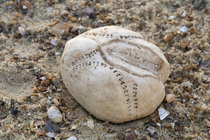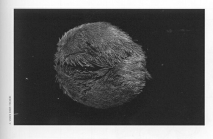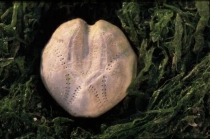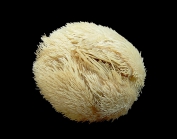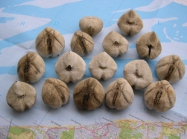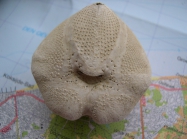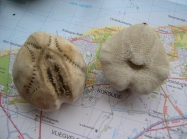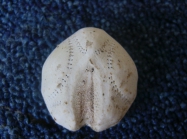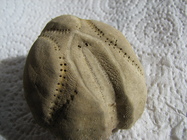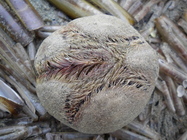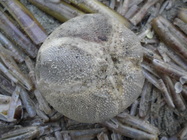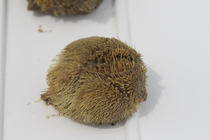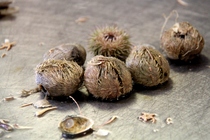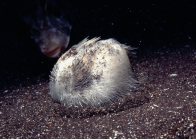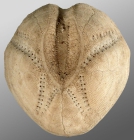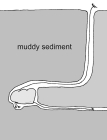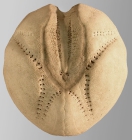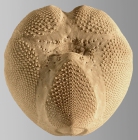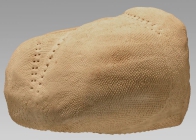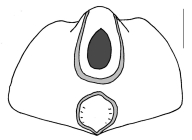WoRMS taxon details
Echinocardium cordatum (Pennant, 1777)
124392 (urn:lsid:marinespecies.org:taxname:124392)
accepted
Species
Amphidetus cordatus (Pennant, 1777) · unaccepted (transferred to Echinocardium)
Amphidetus kurtzii Girard, 1852 · unaccepted (subjective junior synonym)
Amphidetus kürtzii Girard, 1852 · unaccepted (incorrect original spelling)
Amphidetus novae zealandiae · unaccepted (misspelling)
Amphidetus novæ zelandiæ Perrier, 1869 · unaccepted (incorrect original spelling...)
incorrect original spelling (mandatory changed according to ICZN 4th Ed. Article 32.5.2.2.)
Amphidetus novaezelandiae Perrier, 1869 · unaccepted (subjective junior synonym)
Amphidetus zealandicus (Gray, 1851) · unaccepted (subjective junior synonym)
Amphidotus cordatus (Pennant, 1777) · unaccepted (misspelling & transferred to...)
misspelling & transferred to Echinocardium
Echinocardium australe Gray, 1851 · unaccepted (subjective junior synonym)
Echinocardium caudatum · unaccepted (misspelling)
Echinocardium cordatus (Pennant, 1777) · unaccepted (incorrect declination of species name)
Echinocardium kurtzii (Girard, 1852) · unaccepted (subjective junior synonym)
Echinocardium sebae Gray, 1825 · unaccepted (subjective junior synonym)
Echinocardium stimpsonii A. Agassiz, 1864 · unaccepted (subjective junior synonym)
Echinocardium zealandicum Gray, 1851 · unaccepted (subjective junior synonym)
Echinus cordatum Pennant, 1777 · unaccepted (transferred to Echinocardium)
Echinus cordatus Pennant, 1777 · unaccepted (transferred to Echinocardium)
Spatangus arcuarius Lamarck, 1816 · unaccepted (subjective junior synonym)
Spatangus cordatus (Pennant, 1777) · unaccepted (transferred to Echinocardium)
marine, brackish, fresh, terrestrial
recent only
(of Echinus cordatum Pennant, 1777) Pennant, T. (1777). British Zoology, vol. IV. Crustacea. Mollusca. Testacea. <em>London.</em> i-viii, 1-154, pls. 1-93., available online at http://www.biodiversitylibrary.org/item/127011
page(s): 236 [details]
page(s): 236 [details]
Depth range 0-230 m
Description The cordiform body of the sea potato is protected by a calcite skeleton and measures up to 60 mm.
The skeleton is covered...
Distribution This cosmopolitan echinoderrn was found in about half of all samples. The species is very abundant north of the Dutch...
Distribution Cosmopolitan (World Oceans)
Distribution In the 1976-1986 period Echinocardium cordatum was mainly found near the Flemish Banks (maximum 50 ind./m2) whereas it was...
Distribution Lower shore and subtidal to 200 m depth, burrowing in sand or muddy sand, all round the British Isles. Apparently...
Depth range 0-230 m [details]
Description The cordiform body of the sea potato is protected by a calcite skeleton and measures up to 60 mm.
The skeleton is covered...
Description The cordiform body of the sea potato is protected by a calcite skeleton and measures up to 60 mm.
The skeleton is covered with soft spines that lie flat on the body and point towards the back. Yellowish brown in colour. [details]
The skeleton is covered with soft spines that lie flat on the body and point towards the back. Yellowish brown in colour. [details]
Distribution This cosmopolitan echinoderrn was found in about half of all samples. The species is very abundant north of the Dutch...
Distribution This cosmopolitan echinoderrn was found in about half of all samples. The species is very abundant north of the Dutch Wadden islands and is also present in Delta and the western part of the Wadden Sea. The distribution of the biomass is very patchy. [details]
Distribution Cosmopolitan (World Oceans)
Distribution Cosmopolitan (World Oceans) [details]
Distribution In the 1976-1986 period Echinocardium cordatum was mainly found near the Flemish Banks (maximum 50 ind./m2) whereas it was...
Distribution In the 1976-1986 period Echinocardium cordatum was mainly found near the Flemish Banks (maximum 50 ind./m2) whereas it was absent in the eastern coastal zone and near the Hinder Banks. In the 1994-2001 period the species is clearly distributed more widely: E. cordatum was only absent in the eastern coastal zone and reached densities up to 200 ind./m2. As the species lives burrowed in the sand (up to 20 cm deep) there is a real chance that the Van Veen grab fails to scoop up E. cordatum. Consequently, the species may have a broader distribution than mentioned here. [details]
Distribution Lower shore and subtidal to 200 m depth, burrowing in sand or muddy sand, all round the British Isles. Apparently...
Distribution Lower shore and subtidal to 200 m depth, burrowing in sand or muddy sand, all round the British Isles. Apparently cosmopolitan in temperate seas [details]
Kroh, A.; Mooi, R. (2024). World Echinoidea Database. Echinocardium cordatum (Pennant, 1777). Accessed through: World Register of Marine Species at: https://www.marinespecies.org/aphia.php?p=taxdetails&id=124392 on 2024-04-24
Date
action
by
2006-07-18 06:32:47Z
changed
Camba Reu, Cibran
![]() The webpage text is licensed under a Creative Commons Attribution 4.0 License
The webpage text is licensed under a Creative Commons Attribution 4.0 License
original description
(of Echinus cordatus Pennant, 1777) Pennant, T. (1777). British Zoology, vol. IV. Crustacea. Mollusca. Testacea. <em>London.</em> i-viii, 1-154, pls. 1-93., available online at http://www.biodiversitylibrary.org/item/127011
page(s): 69; pl. 34: fig. 75 [details]
original description (of Echinocardium sebae Gray, 1825) Gray, J.E. (1825). An attempt to divide the Echinida, or Sea Eggs, into natural families. <em>Annals of Philosophy, new series.</em> 10:423-431., available online at https://archive.org/stream/annalsofphilosop10lond#page/422/mode/2up
page(s): 430 [details]
original description (of Spatangus arcuarius Lamarck, 1816) Lamarck, J.-B. M. de. (1816). Histoire naturelle des animaux sans vertèbres, <b>Tome troisième</b> [in full: Histoire naturelle des animaux sans vertèbres présentant les caractéres généraux et particuliers de ces animaux, leur distribution, leurs classes, leurs familles, leurs genres, et la citation des principales espèces qui s'y rapportent]. <em>[book series].</em> 586 pp. Paris: Deterville/Verdière., available online at http://www.biodiversitylibrary.org/item/47702
page(s): 32 [details]
original description (of Echinocardium australe Gray, 1851) Gray J.E. 1851. Descriptions of some new genera and species of Spatangidae in the British Museum. The Annals and Magazine of Natural History, 2nd Series 7, 130-134., available online at https://www.biodiversitylibrary.org/page/13787716
page(s): 131 [details]
original description (of Echinus cordatum Pennant, 1777) Pennant, T. (1777). British Zoology, vol. IV. Crustacea. Mollusca. Testacea. <em>London.</em> i-viii, 1-154, pls. 1-93., available online at http://www.biodiversitylibrary.org/item/127011
page(s): 236 [details]
original description (of Echinocardium stimpsonii A. Agassiz, 1864) Agassiz, A. (1864). Synopsis of the echinoids collected by Dr. W. Stimpson on the North Pacific Exploring Expedition under the command of Captains Ringgold and Rodgers. Proceedings of the Academy of Natural Sciences of Philadelphia. 15 (1863), 352-361., available online at https://www.biodiversitylibrary.org/page/1958617
page(s): 360 [details]
original description (of Echinocardium zealandicum Gray, 1851) Gray J.E. 1851. Descriptions of some new genera and species of Spatangidae in the British Museum. The Annals and Magazine of Natural History, 2nd Series 7, 130-134., available online at https://www.biodiversitylibrary.org/page/13787716
page(s): 131 [details]
original description (of Amphidetus novaezelandiae Perrier, 1869) Perrier, E. (1869). Recherche sur les pédicellaires et les ambulacres des astérides et des oursins. <em>Thèses présentées à la Faculté des Sciences de Paris pour obtenir le Grade de Docteur ès Sciences Naturelles Victor Masson et fils, Paris.</em> 5-188, plates 1-7., available online at https://www.biodiversitylibrary.org/page/13976641
page(s): 176 [details]
original description (of Amphidetus novæ zelandiæ Perrier, 1869) Perrier, E. (1869). Recherche sur les pédicellaires et les ambulacres des astérides et des oursins. <em>Thèses présentées à la Faculté des Sciences de Paris pour obtenir le Grade de Docteur ès Sciences Naturelles Victor Masson et fils, Paris.</em> 5-188, plates 1-7., available online at https://www.biodiversitylibrary.org/page/13976641
page(s): 176 [details]
original description (of Amphidetus kurtzii Girard, 1852) Girard, C. F. (1852). Description of two new genera and two new species of Planaria. <em>Proceedings of the Boston Society of Natural History.</em> 4: 210-213., available online at https://www.biodiversitylibrary.org/page/8870920
page(s): 213-214 [details]
context source (Deepsea) Census of Marine Life (2012). SYNDEEP: Towards a first global synthesis of biodiversity, biogeography and ecosystem function in the deep sea. Unpublished data (datasetID: 38), available online at http://www.comlsecretariat.org/wp-content/uploads/2010/06/SYNDEEP-Towards-a-first-global-synthesis-of-biodiversity-biogeography-and-ecosystem-function-in-the-deep-sea-Eva-Ramirez-Llodra-et-al..pdf [details]
context source (Schelde) Maris, T.; Beauchard, O.; Van Damme, S.; Van den Bergh, E.; Wijnhoven, S.; Meire, P. (2013). Referentiematrices en Ecotoopoppervlaktes Annex bij de Evaluatiemethodiek Schelde-estuarium Studie naar “Ecotoopoppervlaktes en intactness index”. <em>Monitor Taskforce Publication Series, 2013-01. NIOZ: Yerseke.</em> 35 pp. (look up in IMIS) [details]
context source (BeRMS 2020) Flanders Marine Institute (VLIZ); (2013). Data collected during the expeditions of the e-learning projects Expedition Zeeleeuw and Planet Ocean. [details]
basis of record Hansson, H.G. (2001). Echinodermata, <B><I>in</I></B>: Costello, M.J. <i>et al.</i> (Ed.) (2001). <i>European register of marine species: a check-list of the marine species in Europe and a bibliography of guides to their identification. Collection Patrimoines Naturels,</i>. 50: pp. 336-351. (look up in IMIS) [details]
additional source Clark, A. M.; Courtman-Stock, J. (1976). The echinoderms of southern Africa. Publ. No. 766. British Museum (Nat. Hist), London. 277 pp. [details]
additional source Southward, E.C.; Campbell, A.C. (2006). [Echinoderms: keys and notes for the identification of British species]. <i>Synopses of the British fauna (new series)</i>, 56. Field Studies Council: Shrewsbury, UK. ISBN 1-85153-269-2. 272 pp. (look up in IMIS) [details]
additional source Muller, Y. (2004). Faune et flore du littoral du Nord, du Pas-de-Calais et de la Belgique: inventaire. [Coastal fauna and flora of the Nord, Pas-de-Calais and Belgium: inventory]. <em>Commission Régionale de Biologie Région Nord Pas-de-Calais: France.</em> 307 pp., available online at http://www.vliz.be/imisdocs/publications/145561.pdf [details]
additional source Mah, C.L.; McKnight, D.G.; Eagle, M.K.; Pawson, D.L.; Améziane, N.; Vance, D.J.; Baker, A.N.; Clark, H.E.S.; Davey, N. (2009). Phylum Echinodermata: sea stars, brittle stars, sea urchins, sea cucumbers, sea lilies. In: Gordon, D.P. (Ed.) (2009). New Zealand inventory of biodiversity: 1. Kingdom Animalia: Radiata, Lophotrochozoa, Deuterostomia. pp. 371-400. [details]
additional source Mortensen, T. (1951). A Monograph of the Echinoidea. V, 2. Spatangoida II. Amphisternata II. Spatangidæ, Loveniidæ, Pericosmidæ, Schizasteridæ, Brissidæ, 593 pp., C. A. Reitzel, Copenhagen.
page(s): 152-157 [details]
additional source Liu, J.Y. [Ruiyu] (ed.). (2008). Checklist of marine biota of China seas. <em>China Science Press.</em> 1267 pp. (look up in IMIS) [details] Available for editors [request]
[request]
additional source Hansson, H. (2004). North East Atlantic Taxa (NEAT): Nematoda. Internet pdf Ed. Aug 1998., available online at http://www.tmbl.gu.se/libdb/taxon/taxa.html [details] Available for editors [request]
[request]
page(s): 69; pl. 34: fig. 75 [details]
original description (of Echinocardium sebae Gray, 1825) Gray, J.E. (1825). An attempt to divide the Echinida, or Sea Eggs, into natural families. <em>Annals of Philosophy, new series.</em> 10:423-431., available online at https://archive.org/stream/annalsofphilosop10lond#page/422/mode/2up
page(s): 430 [details]
original description (of Spatangus arcuarius Lamarck, 1816) Lamarck, J.-B. M. de. (1816). Histoire naturelle des animaux sans vertèbres, <b>Tome troisième</b> [in full: Histoire naturelle des animaux sans vertèbres présentant les caractéres généraux et particuliers de ces animaux, leur distribution, leurs classes, leurs familles, leurs genres, et la citation des principales espèces qui s'y rapportent]. <em>[book series].</em> 586 pp. Paris: Deterville/Verdière., available online at http://www.biodiversitylibrary.org/item/47702
page(s): 32 [details]
original description (of Echinocardium australe Gray, 1851) Gray J.E. 1851. Descriptions of some new genera and species of Spatangidae in the British Museum. The Annals and Magazine of Natural History, 2nd Series 7, 130-134., available online at https://www.biodiversitylibrary.org/page/13787716
page(s): 131 [details]
original description (of Echinus cordatum Pennant, 1777) Pennant, T. (1777). British Zoology, vol. IV. Crustacea. Mollusca. Testacea. <em>London.</em> i-viii, 1-154, pls. 1-93., available online at http://www.biodiversitylibrary.org/item/127011
page(s): 236 [details]
original description (of Echinocardium stimpsonii A. Agassiz, 1864) Agassiz, A. (1864). Synopsis of the echinoids collected by Dr. W. Stimpson on the North Pacific Exploring Expedition under the command of Captains Ringgold and Rodgers. Proceedings of the Academy of Natural Sciences of Philadelphia. 15 (1863), 352-361., available online at https://www.biodiversitylibrary.org/page/1958617
page(s): 360 [details]
original description (of Echinocardium zealandicum Gray, 1851) Gray J.E. 1851. Descriptions of some new genera and species of Spatangidae in the British Museum. The Annals and Magazine of Natural History, 2nd Series 7, 130-134., available online at https://www.biodiversitylibrary.org/page/13787716
page(s): 131 [details]
original description (of Amphidetus novaezelandiae Perrier, 1869) Perrier, E. (1869). Recherche sur les pédicellaires et les ambulacres des astérides et des oursins. <em>Thèses présentées à la Faculté des Sciences de Paris pour obtenir le Grade de Docteur ès Sciences Naturelles Victor Masson et fils, Paris.</em> 5-188, plates 1-7., available online at https://www.biodiversitylibrary.org/page/13976641
page(s): 176 [details]
original description (of Amphidetus novæ zelandiæ Perrier, 1869) Perrier, E. (1869). Recherche sur les pédicellaires et les ambulacres des astérides et des oursins. <em>Thèses présentées à la Faculté des Sciences de Paris pour obtenir le Grade de Docteur ès Sciences Naturelles Victor Masson et fils, Paris.</em> 5-188, plates 1-7., available online at https://www.biodiversitylibrary.org/page/13976641
page(s): 176 [details]
original description (of Amphidetus kurtzii Girard, 1852) Girard, C. F. (1852). Description of two new genera and two new species of Planaria. <em>Proceedings of the Boston Society of Natural History.</em> 4: 210-213., available online at https://www.biodiversitylibrary.org/page/8870920
page(s): 213-214 [details]
context source (Deepsea) Census of Marine Life (2012). SYNDEEP: Towards a first global synthesis of biodiversity, biogeography and ecosystem function in the deep sea. Unpublished data (datasetID: 38), available online at http://www.comlsecretariat.org/wp-content/uploads/2010/06/SYNDEEP-Towards-a-first-global-synthesis-of-biodiversity-biogeography-and-ecosystem-function-in-the-deep-sea-Eva-Ramirez-Llodra-et-al..pdf [details]
context source (Schelde) Maris, T.; Beauchard, O.; Van Damme, S.; Van den Bergh, E.; Wijnhoven, S.; Meire, P. (2013). Referentiematrices en Ecotoopoppervlaktes Annex bij de Evaluatiemethodiek Schelde-estuarium Studie naar “Ecotoopoppervlaktes en intactness index”. <em>Monitor Taskforce Publication Series, 2013-01. NIOZ: Yerseke.</em> 35 pp. (look up in IMIS) [details]
context source (BeRMS 2020) Flanders Marine Institute (VLIZ); (2013). Data collected during the expeditions of the e-learning projects Expedition Zeeleeuw and Planet Ocean. [details]
basis of record Hansson, H.G. (2001). Echinodermata, <B><I>in</I></B>: Costello, M.J. <i>et al.</i> (Ed.) (2001). <i>European register of marine species: a check-list of the marine species in Europe and a bibliography of guides to their identification. Collection Patrimoines Naturels,</i>. 50: pp. 336-351. (look up in IMIS) [details]
additional source Clark, A. M.; Courtman-Stock, J. (1976). The echinoderms of southern Africa. Publ. No. 766. British Museum (Nat. Hist), London. 277 pp. [details]
additional source Southward, E.C.; Campbell, A.C. (2006). [Echinoderms: keys and notes for the identification of British species]. <i>Synopses of the British fauna (new series)</i>, 56. Field Studies Council: Shrewsbury, UK. ISBN 1-85153-269-2. 272 pp. (look up in IMIS) [details]
additional source Muller, Y. (2004). Faune et flore du littoral du Nord, du Pas-de-Calais et de la Belgique: inventaire. [Coastal fauna and flora of the Nord, Pas-de-Calais and Belgium: inventory]. <em>Commission Régionale de Biologie Région Nord Pas-de-Calais: France.</em> 307 pp., available online at http://www.vliz.be/imisdocs/publications/145561.pdf [details]
additional source Mah, C.L.; McKnight, D.G.; Eagle, M.K.; Pawson, D.L.; Améziane, N.; Vance, D.J.; Baker, A.N.; Clark, H.E.S.; Davey, N. (2009). Phylum Echinodermata: sea stars, brittle stars, sea urchins, sea cucumbers, sea lilies. In: Gordon, D.P. (Ed.) (2009). New Zealand inventory of biodiversity: 1. Kingdom Animalia: Radiata, Lophotrochozoa, Deuterostomia. pp. 371-400. [details]
additional source Mortensen, T. (1951). A Monograph of the Echinoidea. V, 2. Spatangoida II. Amphisternata II. Spatangidæ, Loveniidæ, Pericosmidæ, Schizasteridæ, Brissidæ, 593 pp., C. A. Reitzel, Copenhagen.
page(s): 152-157 [details]
additional source Liu, J.Y. [Ruiyu] (ed.). (2008). Checklist of marine biota of China seas. <em>China Science Press.</em> 1267 pp. (look up in IMIS) [details] Available for editors
additional source Hansson, H. (2004). North East Atlantic Taxa (NEAT): Nematoda. Internet pdf Ed. Aug 1998., available online at http://www.tmbl.gu.se/libdb/taxon/taxa.html [details] Available for editors
 Present
Present  Present in aphia/obis/gbif/idigbio
Present in aphia/obis/gbif/idigbio  Inaccurate
Inaccurate  Introduced: alien
Introduced: alien  Containing type locality
Containing type locality
From editor or global species database
Depth range 0-230 m [details]From other sources
Biology Breeding occurs in summer. The pelagic larvae are sometimes found in enormous quantities and likewise the young can be found in large amounts on the sediment surface. The growth rate of E. cordatum varies with the environment. It grows faster in shallow, sandy than in deep, muddy areas, possibly under the influence of temperature. The species can live for 10 to 20 years (Mortensen, 1927; Wolff, 1973; Fish & Fish, 1989; Rees & Dare, 1993).Depending on the temperature, the species digs a few centimetres to about 20 cm deep into the sediment. A respiratory channel (chimney) leads from the hole to the surface and one or two sanitary drains are located horizontally behind the echinoid. The animal is isolated from the sediment by a mucus veil, which plasters the burrow. E. cordatum plays an important role in sediment bioturbation (Mortensen, 1927; De Ridder et al., 1987; Fish & Fish, 1989; Rees & Dare, 1993). E. cordatum is a non-selective deposit feeder. lt collects particles from the s [details]
Breeding Echinopluteus larva. Summer [details]
Description The cordiform body of the sea potato is protected by a calcite skeleton and measures up to 60 mm.
The skeleton is covered with soft spines that lie flat on the body and point towards the back. Yellowish brown in colour. [details]
Distribution This cosmopolitan echinoderrn was found in about half of all samples. The species is very abundant north of the Dutch Wadden islands and is also present in Delta and the western part of the Wadden Sea. The distribution of the biomass is very patchy. [details]
Distribution Cosmopolitan (World Oceans) [details]
Distribution In the 1976-1986 period Echinocardium cordatum was mainly found near the Flemish Banks (maximum 50 ind./m2) whereas it was absent in the eastern coastal zone and near the Hinder Banks. In the 1994-2001 period the species is clearly distributed more widely: E. cordatum was only absent in the eastern coastal zone and reached densities up to 200 ind./m2. As the species lives burrowed in the sand (up to 20 cm deep) there is a real chance that the Van Veen grab fails to scoop up E. cordatum. Consequently, the species may have a broader distribution than mentioned here. [details]
Distribution Lower shore and subtidal to 200 m depth, burrowing in sand or muddy sand, all round the British Isles. Apparently cosmopolitan in temperate seas [details]
Ecology Ecology: benthic, inshore, continental shelf, deposit feeder. General distribution: temperate, discontinuous (west Pacific Ocean, NZ, South Africa, Gulf of California, north Atlantic Ocean), depth range 0-230? m. (Rowe & Gates, 1995).
Also distributed in Australia (Rowe & Gates, 1995). [details]
Habitat Echinocardium cordatum occurs in sediments with a wide range of grain sizes (median grain size up to 650 μm), but clearly prefers sediments with a median grain size of 200 to 300 μm (relative occurrence ± 40%). The species is only found in sediments with a low mud content (< 20%). [details]
Habitat The fact that E. cordatum is present in the entire area (North Sea) indicates that the echinoderm is not very selective with regard to the type of sediment, although a slight preference for sandy bottoms can be detected. Earlier investigations suggest that, indeed, sandy substrates may be favoured (Rees & Dare, 1993). In a study along a transect in the central and southern North Sea, Duineveld & Jenness (1984) found E. cordatum to account for 50% of the benthic biomass at sandy sites and 5% at muddy sites. [details]
Morphology This sea urchin has a heart-shaped test, usually 40-50 mm in length. lt is covered with a large number of closely set spines, most of them directed backwards. In profile the highest point of the test lies towards the posterior. lt is yellow-brown in colour (Mortensen, 1927; Southward, 1972; Fish & Fish, 1989; Hayward & Ryland, 1990). [details]
Remark Type data: status and whereabouts undetermined. Type locality: Unknown (Britain) (Rowe & Gates, 1995). [details]
| Language | Name | |
|---|---|---|
| Albanian | iriqi zemër i detit | [details] |
| Dutch | zeeklithartegel | [details] |
| English | sea-potatoSea potatoheart-urchin | [details] |
| French | oursin-coeuroursin de sable | [details] |
| German | kleiner Herzigel | [details] |
| Japanese | オカメブンブクOkame-bunbuku | [details] |
| Norwegian Bokmål | sandsjømus | [details] |
| Norwegian Nynorsk | sandsjømus | [details] |
| Russian | Настоящий сердцевидный морской еж | [details] |
| Spanish | erizo corazón | [details] |
| Swedish | hjärtsjöborre | [details] |
BIOTIC
Encyclopedia of Marine Life of Britain and Ireland
Marine Life Information Network - UK
To Barcode of Life (69 barcodes)
To Biodiversity Heritage Library (25 publications) (from synonym Echinus cordatus Pennant, 1777)
To Biodiversity Heritage Library (293 publications)
To Biodiversity Heritage Library (44 publications) (from synonym Spatangus arcuarius Lamarck, 1816)
To Biodiversity Heritage Library (46 publications) (from synonym Echinocardium australe Gray, 1851)
To Biodiversity Heritage Library (5 publications) (from synonym Echinocardium zealandicum Gray, 1851)
To Biodiversity Heritage Library (6 publications) (from synonym Echinocardium caudatum)
To Biodiversity Heritage Library (65 publications) (from synonym Amphidetus cordatus (Pennant, 1777))
To Biodiversity Heritage Library (83 publications) (from synonym Amphidotus cordatus (Pennant, 1777))
To Biological Information System for Marine Life (BISMaL)
To Dyntaxa
To European Nucleotide Archive (ENA)
To GenBank (340 nucleotides; 100 proteins)
To Global Biotic Interactions (GloBI)
To PESI (from synonym Echinocardium sebae Gray, 1825)
To PESI (from synonym Spatangus arcuarius Lamarck, 1816)
To PESI
To PESI (from synonym Echinus cordatus Pennant, 1777)
To PESI (from synonym Amphidetus kürtzii Girard, 1852)
To USNM Invertebrate Zoology Echinodermata Collection (1 record) (from synonym Echinocardium australe Gray, 1851)
To USNM Invertebrate Zoology Echinodermata Collection (60 records)
To ITIS
Encyclopedia of Marine Life of Britain and Ireland
Marine Life Information Network - UK
To Barcode of Life (69 barcodes)
To Biodiversity Heritage Library (25 publications) (from synonym Echinus cordatus Pennant, 1777)
To Biodiversity Heritage Library (293 publications)
To Biodiversity Heritage Library (44 publications) (from synonym Spatangus arcuarius Lamarck, 1816)
To Biodiversity Heritage Library (46 publications) (from synonym Echinocardium australe Gray, 1851)
To Biodiversity Heritage Library (5 publications) (from synonym Echinocardium zealandicum Gray, 1851)
To Biodiversity Heritage Library (6 publications) (from synonym Echinocardium caudatum)
To Biodiversity Heritage Library (65 publications) (from synonym Amphidetus cordatus (Pennant, 1777))
To Biodiversity Heritage Library (83 publications) (from synonym Amphidotus cordatus (Pennant, 1777))
To Biological Information System for Marine Life (BISMaL)
To Dyntaxa
To European Nucleotide Archive (ENA)
To GenBank (340 nucleotides; 100 proteins)
To Global Biotic Interactions (GloBI)
To PESI (from synonym Echinocardium sebae Gray, 1825)
To PESI (from synonym Spatangus arcuarius Lamarck, 1816)
To PESI
To PESI (from synonym Echinus cordatus Pennant, 1777)
To PESI (from synonym Amphidetus kürtzii Girard, 1852)
To USNM Invertebrate Zoology Echinodermata Collection (1 record) (from synonym Echinocardium australe Gray, 1851)
To USNM Invertebrate Zoology Echinodermata Collection (60 records)
To ITIS
